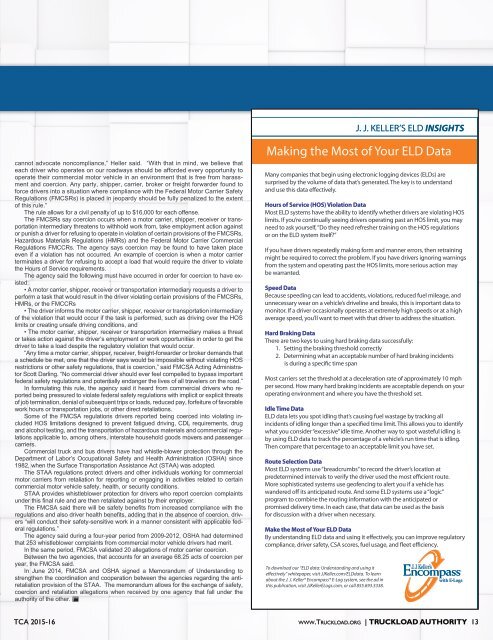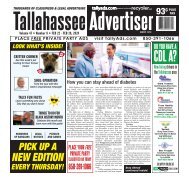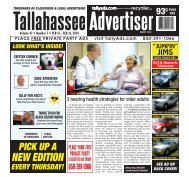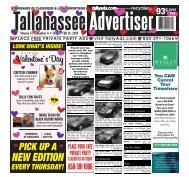Truckload Authority - Winter 2015-16
Count down our list of the top 10 trucking stories of 2015 and get all the details on the $305 billion Fixing America's Surface Transportation Act. Plus, we get the "dirty" truth from international TV star Mike Rowe.
Count down our list of the top 10 trucking stories of 2015 and get all the details on the $305 billion Fixing America's Surface Transportation Act. Plus, we get the "dirty" truth from international TV star Mike Rowe.
You also want an ePaper? Increase the reach of your titles
YUMPU automatically turns print PDFs into web optimized ePapers that Google loves.
J. J. KELLER’S ELD INSIGHTS<br />
cannot advocate noncompliance,” Heller said. “With that in mind, we believe that<br />
each driver who operates on our roadways should be afforded every opportunity to<br />
operate their commercial motor vehicle in an environment that is free from harassment<br />
and coercion. Any party, shipper, carrier, broker or freight forwarder found to<br />
force drivers into a situation where compliance with the Federal Motor Carrier Safety<br />
Regulations (FMCSRs) is placed in jeopardy should be fully penalized to the extent<br />
of this rule.”<br />
The rule allows for a civil penalty of up to $<strong>16</strong>,000 for each offense.<br />
The FMCSRs say coercion occurs when a motor carrier, shipper, receiver or transportation<br />
intermediary threatens to withhold work from, take employment action against<br />
or punish a driver for refusing to operate in violation of certain provisions of the FMCSRs,<br />
Hazardous Materials Regulations (HMRs) and the Federal Motor Carrier Commercial<br />
Regulations FMCCRs. The agency says coercion may be found to have taken place<br />
even if a violation has not occurred. An example of coercion is when a motor carrier<br />
terminates a driver for refusing to accept a load that would require the driver to violate<br />
the Hours of Service requirements.<br />
The agency said the following must have occurred in order for coercion to have existed:<br />
• A motor carrier, shipper, receiver or transportation intermediary requests a driver to<br />
perform a task that would result in the driver violating certain provisions of the FMCSRs,<br />
HMRs, or the FMCCRs<br />
• The driver informs the motor carrier, shipper, receiver or transportation intermediary<br />
of the violation that would occur if the task is performed, such as driving over the HOS<br />
limits or creating unsafe driving conditions, and<br />
• The motor carrier, shipper, receiver or transportation intermediary makes a threat<br />
or takes action against the driver’s employment or work opportunities in order to get the<br />
driver to take a load despite the regulatory violation that would occur.<br />
“Any time a motor carrier, shipper, receiver, freight-forwarder or broker demands that<br />
a schedule be met, one that the driver says would be impossible without violating HOS<br />
restrictions or other safety regulations, that is coercion,” said FMCSA Acting Administrator<br />
Scott Darling. “No commercial driver should ever feel compelled to bypass important<br />
federal safety regulations and potentially endanger the lives of all travelers on the road.”<br />
In formulating this rule, the agency said it heard from commercial drivers who reported<br />
being pressured to violate federal safety regulations with implicit or explicit threats<br />
of job termination, denial of subsequent trips or loads, reduced pay, forfeiture of favorable<br />
work hours or transportation jobs, or other direct retaliations.<br />
Some of the FMCSA regulations drivers reported being coerced into violating included<br />
HOS limitations designed to prevent fatigued driving, CDL requirements, drug<br />
and alcohol testing, and the transportation of hazardous materials and commercial regulations<br />
applicable to, among others, interstate household goods movers and passenger<br />
carriers.<br />
Commercial truck and bus drivers have had whistle-blower protection through the<br />
Department of Labor’s Occupational Safety and Health Administration (OSHA) since<br />
1982, when the Surface Transportation Assistance Act (STAA) was adopted.<br />
The STAA regulations protect drivers and other individuals working for commercial<br />
motor carriers from retaliation for reporting or engaging in activities related to certain<br />
commercial motor vehicle safety, health, or security conditions.<br />
STAA provides whistleblower protection for drivers who report coercion complaints<br />
under this final rule and are then retaliated against by their employer.<br />
The FMCSA said there will be safety benefits from increased compliance with the<br />
regulations and also driver health benefits, adding that in the absence of coercion, drivers<br />
“will conduct their safety-sensitive work in a manner consistent with applicable federal<br />
regulations.”<br />
The agency said during a four-year period from 2009-2012, OSHA had determined<br />
that 253 whistleblower complaints from commercial motor vehicle drivers had merit.<br />
In the same period, FMCSA validated 20 allegations of motor carrier coercion.<br />
Between the two agencies, that accounts for an average 68.25 acts of coercion per<br />
year, the FMCSA said.<br />
In June 2014, FMCSA and OSHA signed a Memorandum of Understanding to<br />
strengthen the coordination and cooperation between the agencies regarding the antiretaliation<br />
provision of the STAA. The memorandum allows for the exchange of safety,<br />
coercion and retaliation allegations when received by one agency that fall under the<br />
authority of the other.<br />
Making the Most of Your ELD Data<br />
Many companies that begin using electronic logging devices (ELDs) are<br />
surprised by the volume of data that’s generated. The key is to understand<br />
and use this data effectively.<br />
Hours of Service (HOS) Violation Data<br />
Most ELD systems have the ability to identify whether drivers are violating HOS<br />
limits. If you’re continually seeing drivers operating past an HOS limit, you may<br />
need to ask yourself, “Do they need refresher training on the HOS regulations<br />
or on the ELD system itself?”<br />
If you have drivers repeatedly making form and manner errors, then retraining<br />
might be required to correct the problem. If you have drivers ignoring warnings<br />
from the system and operating past the HOS limits, more serious action may<br />
be warranted.<br />
Speed Data<br />
Because speeding can lead to accidents, violations, reduced fuel mileage, and<br />
unnecessary wear on a vehicle’s driveline and breaks, this is important data to<br />
monitor. If a driver occasionally operates at extremely high speeds or at a high<br />
average speed, you’ll want to meet with that driver to address the situation.<br />
Hard Braking Data<br />
There are two keys to using hard braking data successfully:<br />
1. Setting the braking threshold correctly<br />
2. Determining what an acceptable number of hard braking incidents<br />
is during a specific time span<br />
Most carriers set the threshold at a deceleration rate of approximately 10 mph<br />
per second. How many hard braking incidents are acceptable depends on your<br />
operating environment and where you have the threshold set.<br />
Idle Time Data<br />
ELD data lets you spot idling that’s causing fuel wastage by tracking all<br />
incidents of idling longer than a specified time limit. This allows you to identify<br />
what you consider “excessive” idle time. Another way to spot wasteful idling is<br />
by using ELD data to track the percentage of a vehicle’s run time that is idling.<br />
Then compare that percentage to an acceptable limit you have set.<br />
Route Selection Data<br />
Most ELD systems use “breadcrumbs” to record the driver’s location at<br />
predetermined intervals to verify the driver used the most efficient route.<br />
More sophisticated systems use geofencing to alert you if a vehicle has<br />
wandered off its anticipated route. And some ELD systems use a “logic”<br />
program to combine the routing information with the anticipated or<br />
promised delivery time. In each case, that data can be used as the basis<br />
for discussion with a driver when necessary.<br />
Make the Most of Your ELD Data<br />
By understanding ELD data and using it effectively, you can improve regulatory<br />
compliance, driver safety, CSA scores, fuel usage, and fleet efficiency.<br />
To download our “ELD data: Understanding and using it<br />
effectively” whitepaper, visit JJKeller.com/ELDdata. To learn<br />
about the J. J. Keller® Encompass® E-Log system, see the ad in<br />
this publication, visit JJKellerELogs.com, or call 855.693.5338.<br />
with E-Logs<br />
TCA <strong>2015</strong>-<strong>16</strong> www.<strong>Truckload</strong>.org | <strong>Truckload</strong> <strong>Authority</strong> 13

















